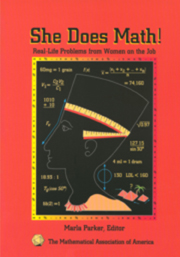Book contents
- Frontmatter
- Preface
- Contents
- Problems by Subject
- Environmental Psychology
- Software Engineering; Computer Science
- Archaeology
- Mathematics and Computer Science
- Civil Engineering
- Mathematics
- Electrical Engineering
- Physics; X-ray Astronomy Research
- Mathematics
- Physics; Astronaut Crew Training Instructor
- Business Data Processing
- Software Engineering; Real Estate Investment
- Quality Engineering
- Health Science
- Nursing Education
- Electrical Engineering; Space Systems
- Oil and Gas Accounting
- Business Administration Higher Education
- Aerospace Engineering
- Structural Engineering
- Computer Science
- Mathematics
- Dietetics—Foodservice Management and Nutrition
- Electrical Engineering
- Chemical Engineering, retired
- Software Engineering
- Immunology and Microbiology
- Mechanical Engineering
- HMO Pharmacy Practice and Management
- Ophthalmology
- Electrical Engineering
- Fish Pathology
- Computer Science and Computer Graphics
- Mathematics and Computing
- Electrical Engineering
- Astronomy
- Author
- Mathematics
- Reflections on WAM
- Solutions
Computer Science and Computer Graphics
- Frontmatter
- Preface
- Contents
- Problems by Subject
- Environmental Psychology
- Software Engineering; Computer Science
- Archaeology
- Mathematics and Computer Science
- Civil Engineering
- Mathematics
- Electrical Engineering
- Physics; X-ray Astronomy Research
- Mathematics
- Physics; Astronaut Crew Training Instructor
- Business Data Processing
- Software Engineering; Real Estate Investment
- Quality Engineering
- Health Science
- Nursing Education
- Electrical Engineering; Space Systems
- Oil and Gas Accounting
- Business Administration Higher Education
- Aerospace Engineering
- Structural Engineering
- Computer Science
- Mathematics
- Dietetics—Foodservice Management and Nutrition
- Electrical Engineering
- Chemical Engineering, retired
- Software Engineering
- Immunology and Microbiology
- Mechanical Engineering
- HMO Pharmacy Practice and Management
- Ophthalmology
- Electrical Engineering
- Fish Pathology
- Computer Science and Computer Graphics
- Mathematics and Computing
- Electrical Engineering
- Astronomy
- Author
- Mathematics
- Reflections on WAM
- Solutions
Summary
As early as I can remember, I enjoyed math in school. It may be difficult for some to believe, but I actually thought that those long homework assignments were fun|though definitely not a breeze!
My high school courses consisted of algebra, geometry, trigonometry and pre-calculus. In 1983, I graduated from St. John's University in Jamaica, New York with a BS in Mathematics. A common question people asked as I went through college was, “So what are you planning to do with your math degree—teach?” Well, I knew that teaching was not for me, so I sought a secondary area of concentration. At that time, St. John's math curriculum offered majors in actuarial science (probability and statistics within the insurance field) and computer science. Since actuarial science required a long-term commitment through ten grueling certification exams, I decided to go with the latest and greatest high tech field. I haven't regretted it since!
In college, I took these math courses: Calculus I, II, III, & IV, Linear Algebra, Honors Seminar in Mathematics (i.e., History of Math), Differential Equations, Complex Variables, and Elementary Number Theory. My computer science courses consisted of: Introduction to Computer Graphics, Introduction to Computing, Fundamentals of Computer Science, Digital Circuits & Computer Organization, Programming Languages, Applied Computer Science, and Systems Software I. In addition, I took Operating Systems and Database Concepts as postgraduate computer science courses.
- Type
- Chapter
- Information
- She Does Math!Real-Life Problems from Women on the Job, pp. 135 - 138Publisher: Mathematical Association of AmericaPrint publication year: 1995



